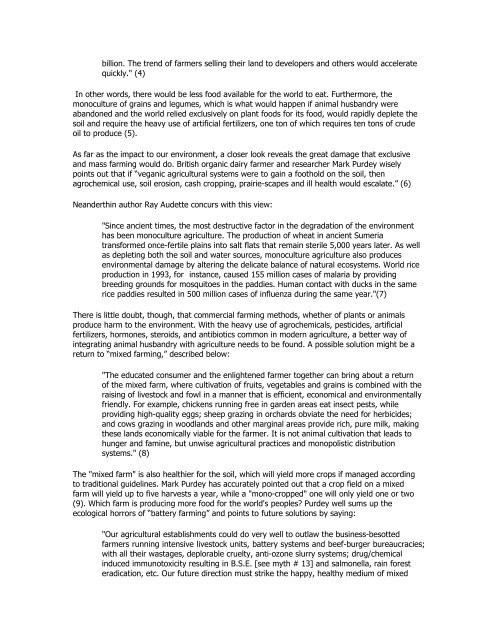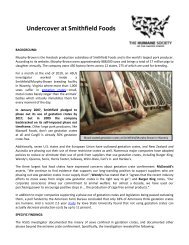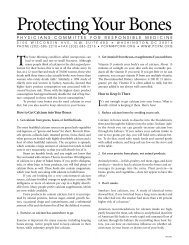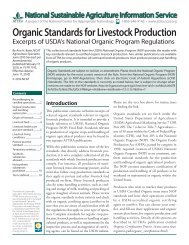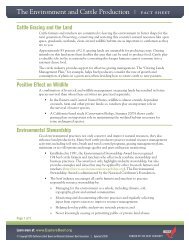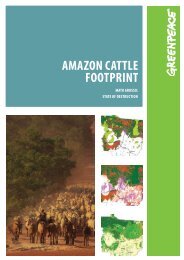THE MYTHS OF VEGETARIANISM Stephen Byrnes, PhD
THE MYTHS OF VEGETARIANISM Stephen Byrnes, PhD
THE MYTHS OF VEGETARIANISM Stephen Byrnes, PhD
Create successful ePaper yourself
Turn your PDF publications into a flip-book with our unique Google optimized e-Paper software.
illion. The trend of farmers selling their land to developers and others would acceleratequickly." (4)In other words, there would be less food available for the world to eat. Furthermore, themonoculture of grains and legumes, which is what would happen if animal husbandry wereabandoned and the world relied exclusively on plant foods for its food, would rapidly deplete thesoil and require the heavy use of artificial fertilizers, one ton of which requires ten tons of crudeoil to produce (5).As far as the impact to our environment, a closer look reveals the great damage that exclusiveand mass farming would do. British organic dairy farmer and researcher Mark Purdey wiselypoints out that if “veganic agricultural systems were to gain a foothold on the soil, thenagrochemical use, soil erosion, cash cropping, prairie-scapes and ill health would escalate.” (6)Neanderthin author Ray Audette concurs with this view:"Since ancient times, the most destructive factor in the degradation of the environmenthas been monoculture agriculture. The production of wheat in ancient Sumeriatransformed once-fertile plains into salt flats that remain sterile 5,000 years later. As wellas depleting both the soil and water sources, monoculture agriculture also producesenvironmental damage by altering the delicate balance of natural ecosystems. World riceproduction in 1993, for instance, caused 155 million cases of malaria by providingbreeding grounds for mosquitoes in the paddies. Human contact with ducks in the samerice paddies resulted in 500 million cases of influenza during the same year."(7)There is little doubt, though, that commercial farming methods, whether of plants or animalsproduce harm to the environment. With the heavy use of agrochemicals, pesticides, artificialfertilizers, hormones, steroids, and antibiotics common in modern agriculture, a better way ofintegrating animal husbandry with agriculture needs to be found. A possible solution might be areturn to “mixed farming,” described below:"The educated consumer and the enlightened farmer together can bring about a returnof the mixed farm, where cultivation of fruits, vegetables and grains is combined with theraising of livestock and fowl in a manner that is efficient, economical and environmentallyfriendly. For example, chickens running free in garden areas eat insect pests, whileproviding high-quality eggs; sheep grazing in orchards obviate the need for herbicides;and cows grazing in woodlands and other marginal areas provide rich, pure milk, makingthese lands economically viable for the farmer. It is not animal cultivation that leads tohunger and famine, but unwise agricultural practices and monopolistic distributionsystems." (8)The "mixed farm" is also healthier for the soil, which will yield more crops if managed accordingto traditional guidelines. Mark Purdey has accurately pointed out that a crop field on a mixedfarm will yield up to five harvests a year, while a "mono-cropped" one will only yield one or two(9). Which farm is producing more food for the world's peoples? Purdey well sums up theecological horrors of “battery farming” and points to future solutions by saying:"Our agricultural establishments could do very well to outlaw the business-besottedfarmers running intensive livestock units, battery systems and beef-burger bureaucracies;with all their wastages, deplorable cruelty, anti-ozone slurry systems; drug/chemicalinduced immunotoxicity resulting in B.S.E. [see myth # 13] and salmonella, rain foresteradication, etc. Our future direction must strike the happy, healthy medium of mixed


